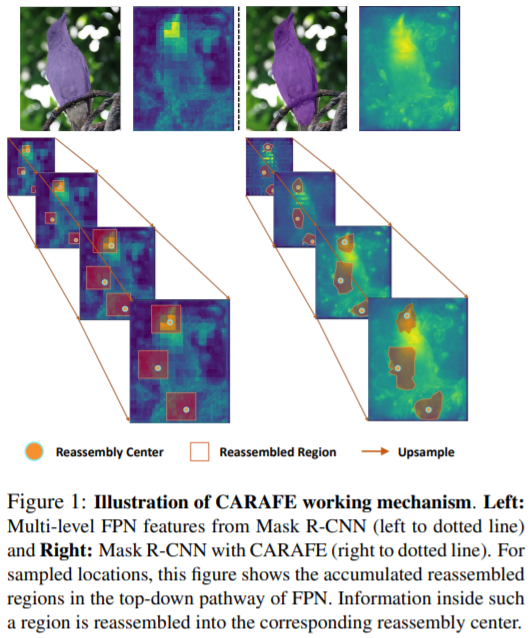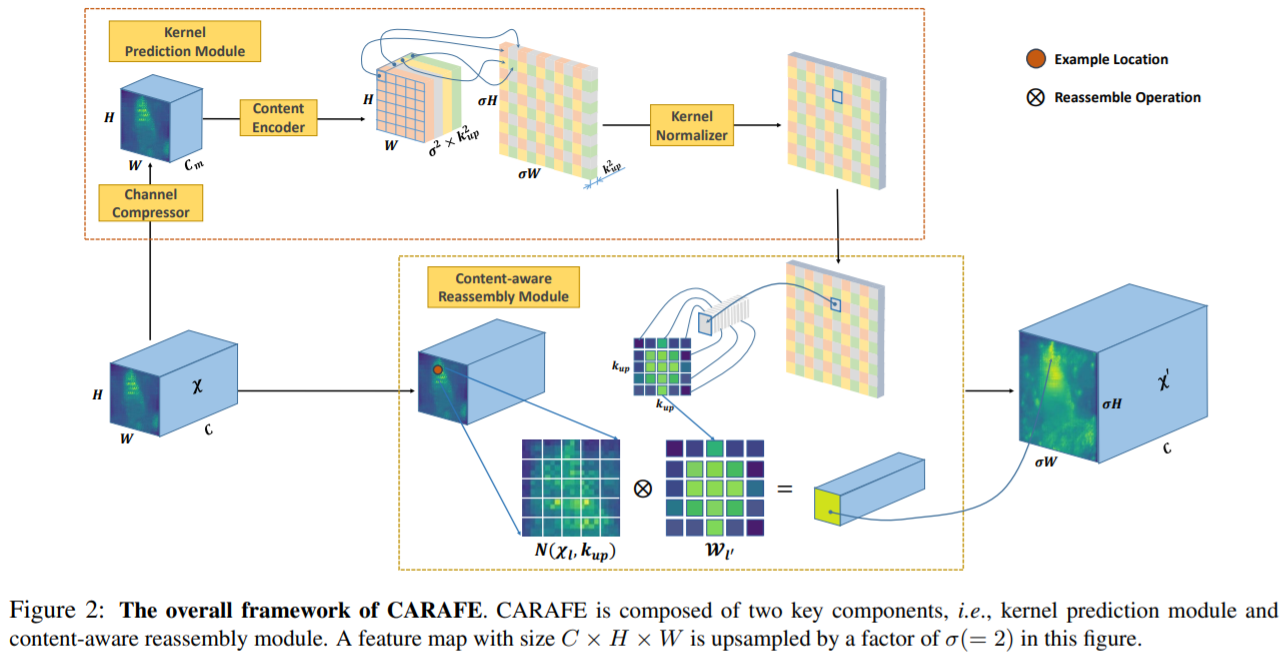『论文笔记』CARAFE: Content-Aware ReAssembly of FEatures
对上采样的优化:动态的选取新像素对哪些原有像素存在依赖
Large field of view. Unlike previous works (e.g. bilinear interpolation) that only exploit subpixel neighborhood, CARAFE can aggregate contextual information within a large receptive field.
Content-aware handling. Instead of using a fixed kernel for all samples (e.g. deconvolution), CARAFE enables instance-specific content-aware handling, which generates adaptive kernels on-the-fly.
上采样的两个主要用处:
1、密集预测任务输出尺寸匹配原图
2、不同尺度特征融合
相关上采样算法:
最近邻算法
双线性插值
反卷积
Pixel Shuffle


kernel prediction module
channel compressor: the channel compressor reduces the channel of the input feature map.
content encoder: the content encoder then takes the compressed feature map as input and encodes the content to generate reassembly kernels.
kernel normalizer: lastly, the kernel normalizer applies a softmax function to each reassembly kernel.
content encoder部分的卷积为了平衡计算量和感受野,设置为kup-2。
相比之下,Content-aware Reassembly Module就简单很多,对每个上采样像素对应的原图位置领域进行加权:

和DCN对比:


两者都考虑到了几何信息,相对DCN本文更快,对初始值更不敏感
两者不同点还是挺大的,DCN分支1会预测分支2每个卷积核的偏移,分支2的卷积参数仍然要靠分支2去学习,这里分支1直接预测分支2的卷积参数了,分支2看起来本身没有需要学习的参数(卷积权重由待学习参数变成了网络预测中间结果了)。
怎么体现自适应:网络推理过程在不同图片上是不一样的,对DCN而言体现在卷积权重的位移,对本文则直接体现在了卷积权重本身的值上。






【推荐】国内首个AI IDE,深度理解中文开发场景,立即下载体验Trae
【推荐】编程新体验,更懂你的AI,立即体验豆包MarsCode编程助手
【推荐】抖音旗下AI助手豆包,你的智能百科全书,全免费不限次数
【推荐】轻量又高性能的 SSH 工具 IShell:AI 加持,快人一步
· 10年+ .NET Coder 心语,封装的思维:从隐藏、稳定开始理解其本质意义
· .NET Core 中如何实现缓存的预热?
· 从 HTTP 原因短语缺失研究 HTTP/2 和 HTTP/3 的设计差异
· AI与.NET技术实操系列:向量存储与相似性搜索在 .NET 中的实现
· 基于Microsoft.Extensions.AI核心库实现RAG应用
· 10年+ .NET Coder 心语 ── 封装的思维:从隐藏、稳定开始理解其本质意义
· 地球OL攻略 —— 某应届生求职总结
· 提示词工程——AI应用必不可少的技术
· Open-Sora 2.0 重磅开源!
· 字符编码:从基础到乱码解决